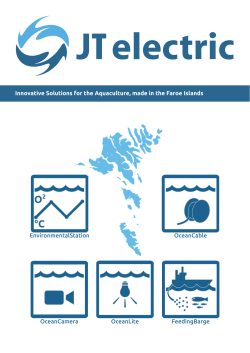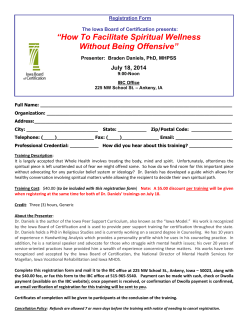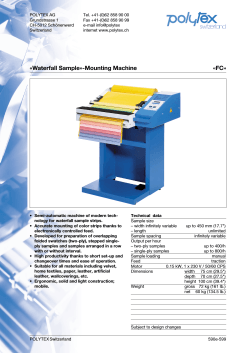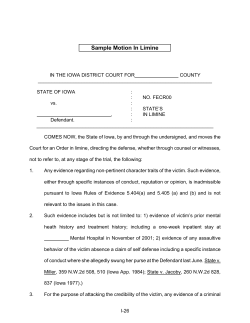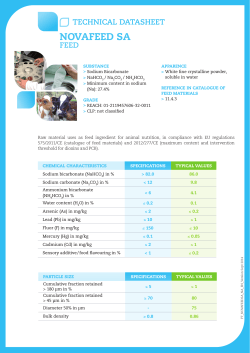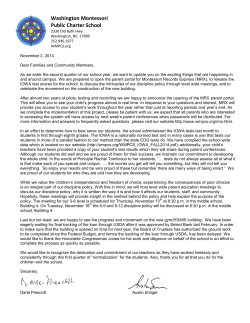
11/18/2014 RAS Must:
11/18/2014 RECIRCULATING AQUACULTURE SYSTEMS: EQUIPMENT AND INFRASTRUCTURE RAS Must: • Remove solid wastes • Settleable, Suspended, and Dissolved • Convert ammonia and nitrite to nitrate • Remove carbon dioxide • Add oxygen J.E. Morris Iowa State University Iowa Aquaculture Conference 2014 Electricity • Maintain proper pH • Control pathogens • Keep up with generation of waste System Components Primary 3-phase electricity • reduce the expense Emergency generator • in event of power outage there is a 30-minute window to restore power to system. • Tanks • Solids filter • Biofilter • Aeration Secondary • Pumps • Heaters/chillers • Lighting • Disinfection Tanks Solids Filtration Construction criteria • Non-toxic • Durable Shape • Economics Sources • Fish wastes • Uneaten food Types of filters • Ergonomics • Sand • System components • Screen • Species under culture • Settling zones • Self-cleansing demands From tanks Clarified Water Solids Collection Iowa Aquaculture Conference 2014 Iowa Aquaculture Conference 2014 1 11/18/2014 Biofilters Ideal Characteristics of Biofilters Forms • Large surface area: volume ratios • Submerged • Long-lasting • Fluidized beds • Cheap • Emerged • Light • Trickling/RBC • Combinations • Bead filters Medium Surface Area/volume (ft2/ft3) Granular carbon 1070 1-inch gravel 101 RBC 64 Media 130 Iowa Aquaculture Conference 2014 Iowa Aquaculture Conference 2014 Management of Biofilters Biological Filtration Live bacteria need time to establish • Sources • Fish metabolism • ~1 month • Easy to kill • Function • Nitrification • Oxidizes ammonia and nitrite to nitrate NH3 1½ O2 nitrosomonas NO2- 1½ O2 nitrobacter NO3- Iowa Aquaculture Conference 2014 Iowa Aquaculture Conference 2014 Ammonia Management Ammonia Management • Byproduct of protein digestion • Need to match bio-filter area with ammonia excretion from feed 0.25 - 1.0 kg Oxygen 0.35 – 1.38 kg CO2 1 kg Feed 0.25 - 0.5 kg Waste Solids 0.18 - 0.4 kg Alkalinity • E.g., 0.189 pounds of feed/day/ft3 of medium (RBC) • 10X in filter weight • Change in feed formulation results in change in ammonia being generated: higher the protein, greater the ammonia • It is not the amount of biomass that can be held, instead it is the amount of feed that can be fed. 0.025 - 0.055 kg NH3 & NH4 2 11/18/2014 Production Rates Oxygenation Oxygen depletion caused by: Variables • Feed ¼ to 1 lb/gal • Aeration • Harvest method Aeration • Aerators Increased Yields • continual • Respiration • Biological oxygen demand • Nitrification • batch • agitators • blowers No Inputs Feed Pumps and Blowers • Oxygen • Liquid oxygen storage • On-site generation Feed Feed Aeration Aeration Continual Harvesting Miscellaneous • Water circulation: • Air-lift • Propeller pumps Lighting • Other needs: • Moving fish • Food propulsion • Side systems (skimmers) Heaters/chillers • Low light levels reduce stress to fish • Depends on species Iowa Aquaculture Conference 2014 Disinfection • • • Use of approved disinfectants Ultraviolet light Ozone Iowa Aquaculture Conference 2014 Remote Monitoring • • • • • • • • • • Temperature Water level Leaks pH Salinity Oxygen Electricity outage Security Motors, e.g., pumps and filters Contacts • On-line monitor • Emergency call to text or cell 3 11/18/2014 Take Home Message • Minimize production costs • Consider cost of production compared to market prices • Manage operations for best production • Be conservative in anticipated production levels • Maintain water quality • More intensive the operation, the greater chance for catastrophic events • Always think of what can happen and plan for it • Don’t be impressed by fish at high densities • Fish can be held at high density with limited feed even in a poorly designed system. • It is the amount of feed that can be fed to the system that is important. • Remember it takes feed to grow fish. 4
© Copyright 2025

